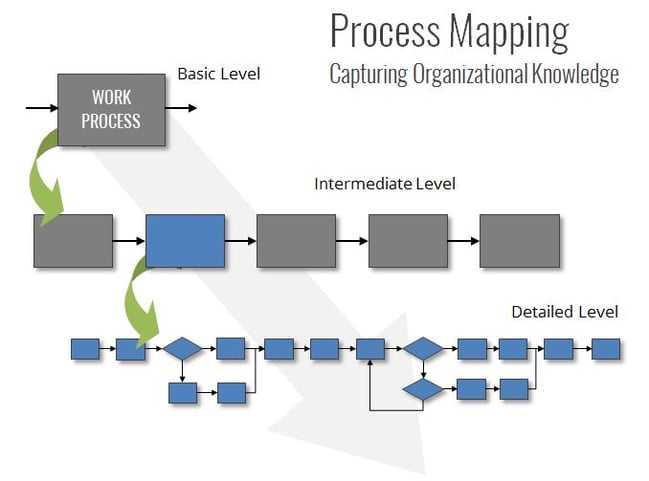Work Process Reliability™
- - - - - - - - - - - - - -
 Optimizing human performance
Optimizing human performance
- - - - - - - - - -
Highly reliable organizations are focused on improving human performance through strong work process. The more effective an organization becomes at executing its work processes, the more effective it becomes at preventing problems from occurring in the first place.
Everyone’s job in a company is to perform particular tasks. Performing the different tasks effectively is what allows an organization to succeed. A company is just a collection of different tasks — many different tasks that interact and function together to produce products or services. How well employees execute those different work processes dictates how effective the organization is. The performance of the people is so important to the success of an organization that the focus must be on the work process. An organization that manages by process has a much easier time talking about the details of a given task, such as what went well and what went poorly, because the discussion is focused on the work process (rather than specific employees). It is significantly easier for people to discuss where a particular task broke down or what was missed or forgotten if the people involved can discuss the process rather than themselves.
An organization that manages by process has a much easier time talking about the details of a given task, such as what went well and what went poorly, because the discussion is focused on the work process (rather than specific employees). It is significantly easier for people to discuss where a particular task broke down or what was missed or forgotten if the people involved can discuss the process rather than themselves.
It’s at this point some people — usually managers and executives — may begin shaking their heads. To them, this sounds like a soft, touchy-feely approach that doesn’t hold people accountable. But it is precisely this focus on the process that raises accountability with an organization. Ask the pilot on your next flight if they go through a defined work process, captured on a checklist, every time the plane departs the gate. Involving the people who do the work in this process raises accountability, allows people to take ownership of their work, and provides a way to give feedback without incriminating themselves. Here are three simple points:
- Objectivity: You get people to talk about the task – not themselves.
Benefit: People are less defensive because the dialogue is about where the process broke down. After a task is detailed, it’s important to ask those people who perform the work: “If we want to ensure that this doesn’t happen again, what steps should we take?” - Insight: You get a level of detail that’s known only to the people who do the work.
Benefit: This insight is typically squandered in most organizations. Any time an organization looks at a task in detail, subtle nuances and interesting know-how is revealed. - Ownership of ideas: You get solutions from the people who do the work.
Benefit: Employees own the solutions. They’re responsible for making their solutions work. The adults shouldn’t need to be told what to do like children. The message should be: “We need you to help us solve this. No one knows this task better.”
 How to do this
How to do this
- - - - - - - - - -
Work Process Reliability can be achieved by accessing the “know-how” that already exists within your organization. You don’t need high-priced consultants or expensive software to improve reliability. There is valuable information, insight, and ideas that are hidden within the heads of your people that you are currently forfeiting. We can show you how to access it.
A highly reliable work process dictates roles, sequence, priorities, tools, critical elements, and most important decisions people must make within a task. It is a collection of what the organization knows to be effective. To expose it, simply rely on your most valuable resource, your people. Our approach is simple, efficient, and effective.
 Map the current state work process
Map the current state work process
- - - - - - - - - -
You can get a glimpse of the opportunity within your organization by capturing the process flow for just one work process or task in your department. What organizations typically don’t do is map specific tasks to the level of detail where the work is done. This requires involvement from the people who do the work. This is not a three-day, off-site retreat to map work processes at a generic level — it’s a fifteen-minute discussion with people who do the work, where supervisors or managers ask, “Is any part of this task confusing, frustrating, or taking too long?”
The answer? Usually “Yes.” And there’s valuable insight in the answers from the employees at this level of detail. A good follow-up question: “Is there a better way to accomplish this task?” Again, the answer is usually, “Yes.” At that point, participation begins.
Our Facilitators are experts at revealing the hidden details necessary to improve results within your organization. We have a three-phased approach that helps expose opportunities and improve your work process reliability. If you’re interested, identify a work process and request a quote today.
If you can’t describe what you are doing as a process, you don’t know what you’re doing.
– W. Edwards Deming

